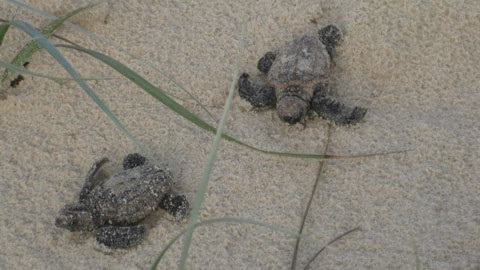Marine turtle nesting and protection

Moreton Bay hosts 6 of the world’s 7 species of marine turtle. Green and loggerhead turtles are the most common species found in our coastal waters. Others include hawksbill, flatback, olive ridley and leatherback turtles.
Moreton Bay has the privilege of sea turtles nesting on our beaches. Loggerhead turtles, and sometimes green turtles, come to Woorim Beach, Bribie Island to lay their eggs each year. They sometimes nest on Redcliffe's sandy beaches as well.
Nesting season is between November and April. Female turtles nest near where they were born. They can lay up to 125 eggs per clutch several times in a season.
While this may seem like a lot of eggs, loggerhead turtles do not breed until around 30 years of age. Females will only nest every 2 to 6 years. Hatchlings have a low chance of survival. It is estimated that only 1 in 1,000 reach maturity.
Threats to turtles and hatchlings
Sea turtles are vulnerable to human disturbance. Threats to turtles and hatchlings include:
- marine debris like plastics and discarded fishing gear
- boat strike
- accidental catches by fisheries
- damage to nests caused by vehicles
- predation of nests by feral animals such as pigs and foxes
- artificial lighting.
What you can do to help protect sea turtles
Turtles and artificial light
Most turtle nesting and hatching happens in the darkness of night. Lighting along the coast can affect turtles in varied and subtle ways. Disturbance can be from a single light source or the collective glow of developed areas.
Turtle hatchlings rely on lighting and topography cues to get from their nest to the ocean. Artificial lighting may disorient hatchlings. This can cause them to head landward instead of to the water.
Bright lights may also prevent adult turtles from coming onto a beach to lay their eggs. They then dump their eggs at sea rather than nest.
Visitors and residents should avoid shining bright lights on beaches during nesting season. If you live next to a beach, switch off unnecessary lights or close curtains and blinds from 7:30 PM.
Find out more about turtles and artificial lighting.
Protecting turtle nesting grounds and habitat
Keep off the sand dunes where turtles may be nesting. The dunes are a critical habitat for nesting turtles and are highly sensitive.
Turtles live in the waters of Moreton Bay Marine Park. Visitors should:
- dispose of plastics and unwanted fishing gear responsibly
- keep vessels at reduced speeds in estuaries, sandy straits and shallow inshore areas
- follow directions in go-slow areas for turtles and dugongs.
You can also join a Council Bushcare group. Get hands-on with conservation and habitat restoration activities. Find out more about Bushcare.
What Council is doing to help sea turtles
Council is working to reduce light to nesting beaches. This includes:
- modifications to light fixtures in public areas
- installation of shade cloth barriers behind identified vulnerable turtle nests on Woorim Beach
- education programs for residents who live close to beaches.
Sand dunes receive ongoing rehabilitation including adding native plants in turtle nesting areas.
Council is also monitoring sand temperatures on turtle-nesting beaches. This is a collaborative project with other councils. The results will help develop long-term strategies to increase turtle nesting habitat suitability.